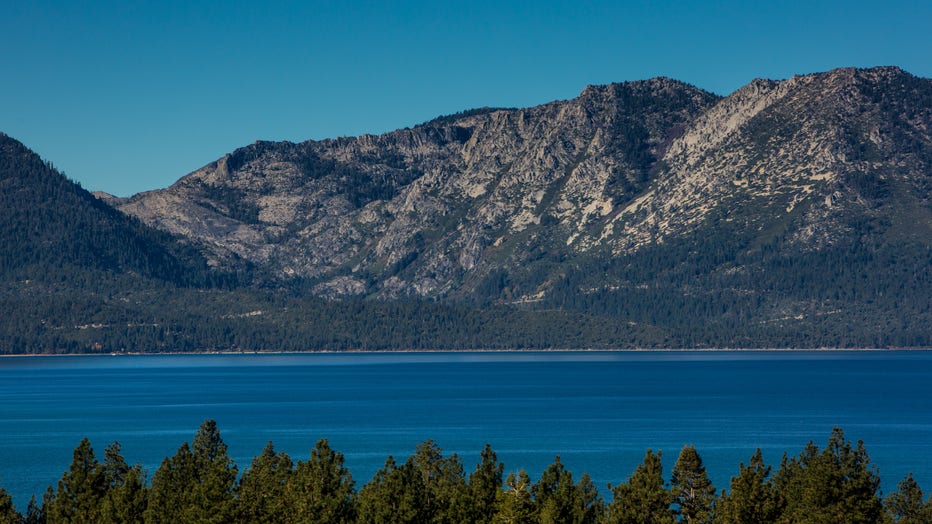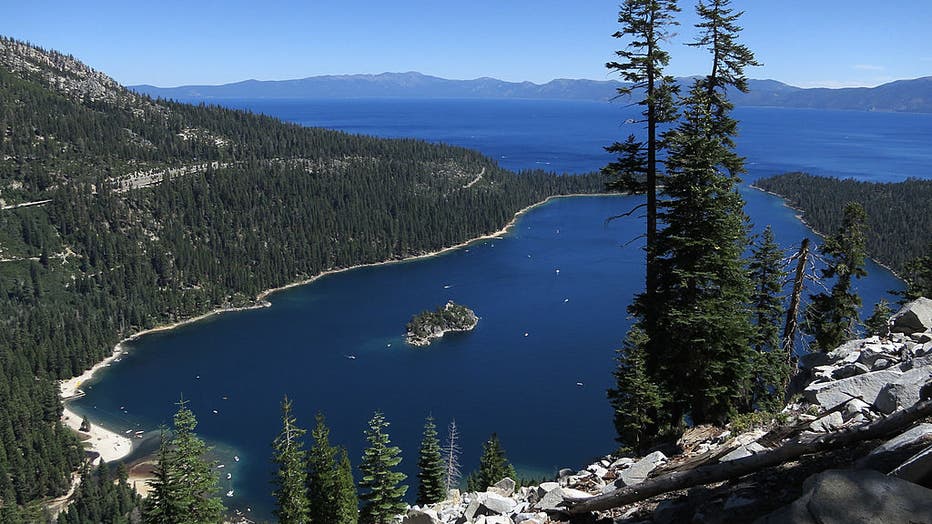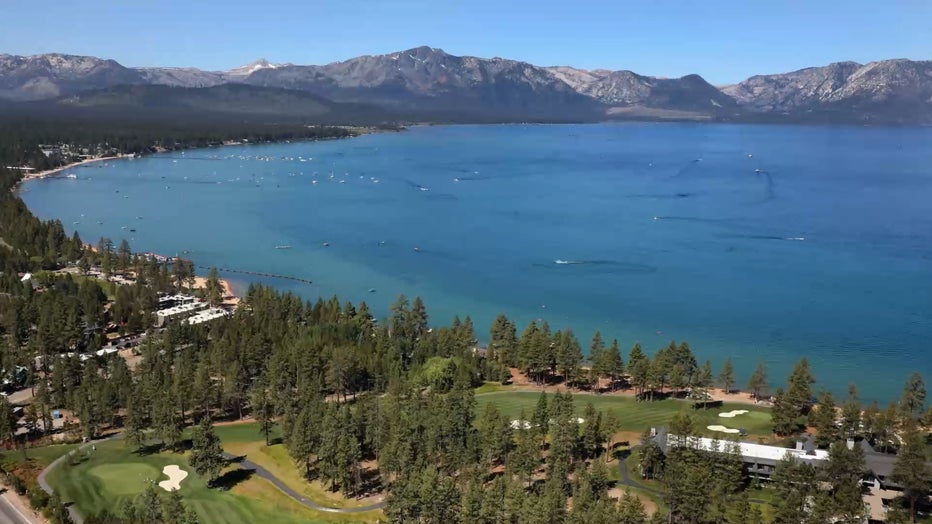Future of Lake Tahoe water clarity remains uncertain following Caldor Fire
Lake Tahoe, United States, August 8, 2017. A wooden pontoon on Lake Tahoe in good weather. (Photo by Emeric Fohlen/NurPhoto via Getty Images)
CARSON CITY, Nev. - When a wildfire crested the mountains near North America's largest alpine lake, embers and ash that zipped across a smoky sky pierced Lake Tahoe’s clear blue waters.
The evacuation order for thousands to flee their homes has been lifted, but those who returned have found black stripes of ash building up on the shoreline — a reminder that success fighting the Caldor Fire won’t insulate the resort region on the California-Nevada line from effects that outlast wildfire season.
Scientists say it’s too soon to draw conclusions about the lasting damage that record-setting wildfires will have on Lake Tahoe. But they’re not wasting time. Many expect to bring their research plans to the Tahoe Science Advisory Council at a meeting Thursday.
Scientists funded by California, Nevada and the League to Save Lake Tahoe are researching lake clarity and biodiversity during and after wildfires. They’re using collection buckets — some loaded with glass marbles — to capture and measure the size and quantity of particles and pollutants from wildfires that have sullied the normally crystal-clear waters. They’re studying how particles enter the lake, how they move around it and the effect on algae production.

SOUTH LAKE TAHOE, CA - OCTOBER 25: A clear day on the lake is ahead on October 25, 2015, in South Lake Tahoe, California. Gambling, real estate, and construction have made gains economically in recent months despite the on-going drought conditions. (
The clarity of the iconic alpine lake can vary even without catastrophic wildfires. On average, Lake Tahoe is clear 65 feet below the water’s surface. Through wildfire season, scientists stationed near the lake's center have only been able to see 50 feet below the surface — a reduction they aren’t sure is due to particles, algae or simply lack of sunlight, said Geoff Schladow, professor of civil and environmental engineering and director of the University of California, Davis' Tahoe Environmental Research Center.
"My feeling is, in some ways, it may look worse than it is," Schladow said. "What smoke in the basin actually does, particularly when it lasts for months, is something we don’t really know. We’re finding that out as we speak."
Smoke from Northern California wildfires has cloaked the Lake Tahoe basin in some past years. But as blazes have grown in size and intensity — partially due to climate change, scientists say — smoke from wildfires inside and outside the basin that has sat atop the lake for two to three months in the past two wildfire seasons has exceeded the expectations of many residents and tourists who flock to the deep blue lake for its clean alpine air and fragrant pine trees.
It’s also concerned scientists, who have spent years studying how algae, erosion and air pollution from vehicles that 15 million tourists drive in each year affect clarity. They say the sheer amount of wildfire smoke that has lingered could harm lake clarity in ways that weren’t previously considered.

SOUTH LAKE TAHOE, CA - MARCH 5: A pinkish color lights the sky over the mountains before sunrise on March 5, 2020, in South Lake Tahoe, California. After a series of heavy snowstorms in December, the moisture flowing off the Pacific Ocean and into th
"Our bread-and-butter sources of declining lake clarity are pretty well understood," said Allison Oliver, an ecologist at the Skeena Fisheries Commission in western Canada who studied how rivers and creeks delivered murky sediment to Lake Tahoe after the 2007 Angora Fire.
"This new phenomenon where we’re getting these big shifts in climate regimes and this pattern of big summer fires," she said of the Sierra Nevada mountains, "that’s not something that was on people’s radar as much 15 or 20 years ago. Now, it’s routine."
On many days, smoke has blotted out views of the mountains that wrap the lake’s pristine waters and left an inescapable campfire stench on clothes, in cars and beneath fingernails.
"It’s really apparent that we need to be concerned about not only fires burning in the basin that cause erosion and burn scars, but the smoke generated from massive fires outside the basin," said Jesse Patterson, the League to Save Lake Tahoe’s chief strategy officer. "We need to think bigger, if we want to keep Tahoe blue decades to come."

SOUTH LAKE TAHOE, CA - JULY 23: Emerald Bay lies under blue skies at Lake Tahoe on July 23, 2014 near South Lake Tahoe, California. Lake Tahoe is among Califonria's major tourist attractions. (Photo by Sean Gallup/Getty Images)
The league, best known for its "Keep Tahoe Blue" bumper stickers, has aggressively pursued environmental restoration projects to maintain the lake’s clarity, prevent erosion and replant burn scars. But amid accelerating climate change, Patterson fears local land management efforts may no longer be enough to protect the lake.
Scientists fear alpine lakes can act as "sponges," soaking up the microscopic particles in wildfire smoke, said Sudeep Chandra, a biology professor and director of the Global Water Center at the University of Nevada, Reno. Regardless of whether studies end up showing smoke obscures algae-fighting sunlight or increases the flow of pollutants into the lake, he believes the challenge for scientists will be expanding the scope of research into factors affecting Lake Tahoe.
Chandra applauded efforts to maintain lake clarity through restoring rivers, preventing erosion and encouraging responsible development. But after he saw how much smoke from California's Dixie Fire further north in the Sierra Nevada ended up in the basin, he said questions about the lake’s future need to reckon with broader climate change trends.
"We’re clearly regionally connected. That’s going to be a new way of thinking about managing the Lake Tahoe basin," he said.

SOUTH LAKE TAHOE, NEVADA - JULY 12: Aerial view over the eighth and ninth holes at Edgewood Tahoe South course during the final round of the American Century Championship on July 12, 2020 in South Lake Tahoe, Nevada. (Photo by Christian Petersen/Gett

